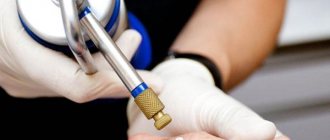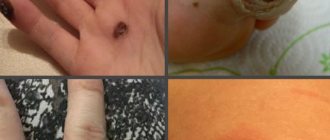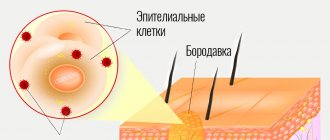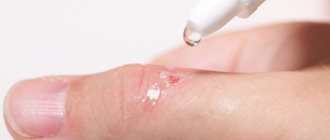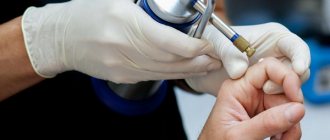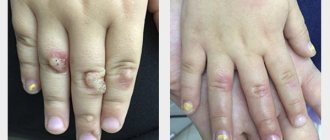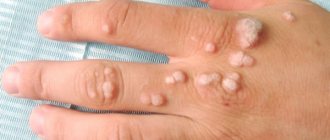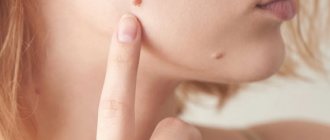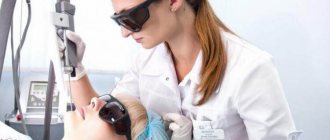The appearance of warts on the body has an unattractive appearance that confuses many people. Warts may not cause any discomfort, however, there are cases when this type of formation causes discomfort and requires removal.
At the moment, it is possible to remove unwanted formations on the skin using various methods; most often, warts are removed with nitrogen. This method helps to quickly and painlessly eliminate the formation without the risk of any relapses.
After the growth is removed with nitrogen, no trace remains on the patient’s skin; in addition, this type of procedure is affordable and is used for all types of warts.
What is a wart and what does it look like?
A wart is a benign neoplasm that appears on the epidermis as a result of damage to skin cells by the papilloma virus.
As a result of the destruction of healthy epidermal cells, the stratum corneum increases and a growth appears on the skin.
Most often, this type of formation is painless, but sometimes there are cases when, as a result of damage to the integrity of the surface of the growth, a person feels pain.
These types of formations can be located in absolutely any area of the body and come in various shapes and sizes.
Externally, warts look like a skin nodule that has a rough surface and most often differs in color from the natural shade of the skin.
Warts can be of the following types:
- Ordinary - formations that appear most often on the hands and do not give a person any unpleasant sensations;
- Plantar - formed on the soles of the feet, most often have painful symptoms and interfere with the normal process of walking. Visually similar to corns, however, more difficult to remove;
- Youthful - formations that practically do not exceed the level of the skin and differ slightly from the natural shade of the epidermis;
- Pointed - formations, most often appear in the axillary and groin area, are small nodules that, when fused together, form ridges.
Common wart Plantar wart Juvenile warts Pointed wart
A wart most often appears as a result of damage to the skin and untimely treatment with an antiseptic.
Warts also very often appear as a result of improper personal hygiene and visiting public places.
Burning out formation
There are several methods for removing spines using liquid nitrogen:
- reed method;
- open spray;
- probe;
The reed method is the simplest and is often used in cryotherapy. The liquid substance is applied to the surface of the spine with a wooden stick and cotton wool. An open spray is suitable for large lesions and allows nitrogen to be sprayed evenly over the affected area.
Probe – for removing small and deep-lying formations.
The choice of method for supplying liquid refrigerant is decided by the dermatologist, based on the location, size, and depth of distribution of the spine.
Preparing for the procedure and is it painful?
No special preparation is required before removing the spine. Before the procedure, you need to consult a specialist, make sure the formation is benign, and confirm the diagnosis. Then the nitrogen destruction method is determined. The reed or open spray method is more often used.
Need advice from an experienced doctor?
Get a doctor's consultation online. Ask your question right now.
Ask a free question
Having determined the technique, the spine and the skin around it are treated with liquid antiseptics. For this, use Chlorhexidine or Betadine.
After several treatments with nitrogen, anesthesia is given before removal, which is selected according to the patient’s pain threshold and the stage of wart growth.
In case of severe pain, the spine is injected with Novocaine or other local anesthetic. The growths on the heels are especially painful.
Freezing
A stick with cotton wool at the end is dipped into a container with nitrogen. Then immediately press the spine to the surface. The liquid form of the substance, having a temperature of -196° Celsius, freezes the tissue of the plantar wart instantly.
Exposure time is from 10 to 40 seconds, depending on the size of the formation and the depth of the lesion. Considering the benign nature of the growth, they try to minimize the time of freezing with liquid nitrogen; only cells localized in the epidermis need to be removed.
After the first pressing, the surface of the spine turns pale, thickens, frost appears, which disappears as it thaws. The time allotted for thawing is 2-3 times longer than for freezing.
During one procedure, 2 to 5 nitrogen applications are performed. At the end of the session, the site of cauterization of the spines is treated with a liquid antiseptic and covered with a bandage.
Wart removal occurs by the following mechanisms:
- the destructive effect of nitrogen due to the formation of ice crystals in cellular elements;
- during thawing, the concentration of ions in the spine cells increases and the electrolyte balance is disturbed;
- Liquid freezing causes temporary spasm of blood vessels and impaired microcirculation.
Wound care
After cauterization with nitrogen, the spine swells and turns red. Then a bubble appears with liquid serous or hemorrhagic contents. This is a normal skin reaction to extremely low temperatures. A hyperemic rim may appear around the vesicle, which soon disappears. At this moment, necrosis of the wart begins to develop.
Pain syndrome after removal with nitrogen is insignificant. Painkillers are not prescribed. Within two weeks after cauterizing the spine with a liquid substance, the bubble will subside. Then the vesicle cover should turn black and turn into a scab.
Regeneration of the epithelium will occur within 4-6 weeks, depending on wound care. While healing, the wound may itch. You should not comb it, this can lead to secondary infection of the wound and complications.
Wound care after wart removal with liquid nitrogen:
- maintaining foot hygiene;
- providing rest to the leg where the spine was located;
- daily treatment with antiseptics - Panthenol, Chlorhexidine, peroxide;
- Do not apply creams or other skin care products to the wound surface;
- You can use keratoplastic medicinal substances after the formation of a scab - Solcoseryl, zinc ointment, salicylic ointment.
During the recovery period, it is prohibited to independently remove crusts, open blisters with liquid contents, scratch the wound, overheat, or hypothermia of the leg. The consequences of non-compliance with the rules are the formation of a scar, hyperpigmented or hypopigmented spot in the place of the spine eliminated with nitrogen.
Failure to maintain personal hygiene can lead to bacterial infection after removal with nitrogen. As a result, a clinic of inflammation is observed. A bursting or pulsating pain will appear. It will gradually increase until it becomes so pronounced that it will be impossible to lean on the leg. Hyperemia and swelling will increase around the wound. Soon the damage will begin to fester. If the accumulation of pus is superficial, the pus is likely to break out. In response to inflammation, the temperature of the body and the damaged area will increase.
In this case, you need to urgently consult a doctor. He will prescribe antibacterial therapy after using nitrogen, and will debride the wound after removing the spine with a liquid chemical. You should not try to remove pus at home.
When should a wart be removed?
A wart can be removed at any time if it gives a person discomfort or interferes with work, but there are some situations in which wart removal is necessary.
Such situations include:
- Rapid increase in size;
- Pain and burning when pressed;
- Isolation of blood from the formation;
- Additional ones appeared at the site of formation;
- Warts that are present on the hands and lead to regular damage during work;
- On the foot when a wart prevents normal movement;
- Formation of warts on the genitals.
Before removing a wart, it is recommended to first undergo all tests and consult a doctor.
Removing warts with liquid nitrogen
The liquid nitrogen removal procedure or cryodestruction is aimed at performing the following tasks:
- Cells damaged by the virus are eliminated by freezing with liquid nitrogen;
- When applied correctly, the risk of burns is reduced to a minimal percentage;
- The possibility of reoccurrence of formation at the site of removal is eliminated;
- Thanks to this removal method, the duration of exposure to nitrogen does not take more than 30 seconds.
Using cold to remove warts allows you to quickly start the natural processes of cell regeneration.
Advantages and disadvantages of the method
| Advantages | Flaws |
| After removal there are practically no traces left | When removing deep-rooted warts, a slight burn may occur. |
| Nitrogen does not affect the condition of healthy skin fibers | Removal of large warts is carried out in several sessions |
| Nitrogen helps remove viral compounds, which reduces the likelihood of new growths forming | A formation that is removed cannot be studied |
| There is no bleeding during removal | Depending on the individual characteristics of the patient, swelling of the skin may be observed after the method. |
| No need to use anesthesia | |
| Removal is quick | |
| Small amount contraindication |
However, despite all the pros and cons of the procedure, this method of wart removal is very popular and is provided in almost all clinics.
What warts can be removed with liquid nitrogen?
Liquid nitrogen is used to remove the following types of warts:
- Plantar formations - a method used to remove warts on the feet and toes. To carry out this type of procedure, a special device is used, since in the area of the feet it is necessary to carry out a longer impact on the formation;
- Common warts - the procedure for removing this type of wart with nitrogen occurs quite quickly, and is used for the hands and feet. This type of procedure is very convenient, since these types of warts are rarely formed as a single specimen, much more often they are a cluster of formations, the removal of which can be carried out in several procedures;
- Senile - for such removal, nitrogen is applied manually and requires several applications. Also, when removing such warts, it is very important to take into account the size and number of formations on the body. Used for areas of the body such as arms, legs, face, back and abdomen;
- Flat - it is recommended to use nitrogen, since this type of procedure is considered the most gentle compared to other methods. Most often, the appearance of flat warts is accompanied by a large number, so several procedures are necessary to remove the formations. Used for all areas of the body except the breasts in women, the axillary and groin areas.
Each type of wart requires special treatment, so the duration of the procedure most often depends on the type of wart and the degree of neglect of the skin lesion by the virus.
What contraindications does the procedure have?
Like any type of procedure affecting the skin, removal of warts with nitrogen has the following types of contraindications:
- Swelling of the skin;
- Skin damage;
- Epileptic seizures;
- Oncological type education;
- Colds;
- Pregnancy;
- Children under 7 years of age;
- High blood pressure;
- Individual sensitivity to cold;
- The presence of inflammatory processes in the human body;
- Allergic reactions on the skin near the location of the infectious node.
If nitrogen removal is carried out in the presence of any contraindication, complications and aggravation of the disease may occur.
How to prepare for the procedure?
Before carrying out the procedure for removing warts with nitrogen, the following preparatory procedures must be carried out:
- Consult your doctor;
- Pass all necessary tests;
- Avoid taking any medications;
- Cleanse the skin of various cosmetics.
During the procedure, the patient must carefully monitor his health and, if it worsens, immediately notify the specialist.
How should a patient behave after cryodestruction?
After completing the procedure, it is important:
- when forming a bubble, try not to injure it, do not rub, do not scratch;
- in case of accidental trauma to the bladder, treat the lesion with solutions of aniline dyes (fucorcin, methylene blue) or a strong solution of manganese to prevent secondary infection;
- disinfect household items (washcloths, towels, shoes, manicure and pedicure tools);
- maintain hygiene of clothing and footwear;
- if there is redness, pain, discharge from the lesion, consult a specialist.
Features of removing different types of warts with nitrogen
Depending on the type of wart, the following treatment features are observed:
- Flat warts are removed as follows: In a single case, nitrogen is applied to the growth with a cotton swab;
- For a large number of warts, cryomassage with nitrogen is used. To do this, nitrogen is applied to the cotton wool and the area where the formations accumulate is applied with quick circular movements;
- Most often, flat warts do not form a blister, but begin to peel off and disappear after a few weeks;
- Plantar warts are removed in several sessions, since most often such formations have deep-rooted roots;
The remaining species are removed in a classic manner and do not require special tools for applying nitrogen.
The need for a repeat procedure
The procedure is repeated in the following situations:
- For large warts, several sessions are recommended;
- If the root of the wart is located deep in the layers of the skin;
- When the crust fell off, the growth did not completely disappear;
- In cases where the boundaries of the wart remain with the presence of affected skin, it most often manifests itself in the form of inflammatory formations.
Most often, it turns out that only small formations can be eliminated at a time; all other types require several nitrogen exposure procedures.
Is the procedure painful?
The degree of pain depends on the individual characteristics of the person, as well as on the size of the wart that will be treated with nitrogen. The sensation of touching nitrogen on the skin is similar to a cold metal object.
A person undergoing nitrogen cauterization may experience the following unpleasant sensations:
- Mild tingling sensation;
- Feeling of cold at the site of nitrogen exposure;
- Numbness of the area where the wart is located;
- A burning sensation at the site of nitrogen exposure most often occurs at the end of the procedure.
For children, it is recommended to use ointments with an analgesic effect; adults carry out such procedures only at their own discretion.
In some cases, discomfort may last for several days, depending on the size of the formation and the duration of exposure of the skin surface to nitrogen.
Advantages and Disadvantages of Nitrogen Removal
Cryodestruction is a type of surgical treatment based on the destruction of tissue at low temperatures. A common and accessible method of treating spines.
Benefits of removing warts using liquid nitrogen:
- The procedure is completed quickly.
- Bloodlessness.
- Low likelihood of infectious complications.
- Minor damage to surrounding tissues.
- Cauterization of the spine with liquid nitrogen does not leave scars.
- Analgesic effect due to freezing during removal.
- Availability.
- Hemostatic effect of freezing.
Disadvantages of the nitrogen method:
- Long healing period for skin defects.
- The likelihood of incomplete removal of the spine with nitrogen in case of violation of the execution technique.
- It is impossible to accurately control the temperature at the site of pathology, which can lead to damage to deeper tissues by the liquid chemical.
- The need for several repetitions of the procedure.
The result of removal depends on the practical skills and qualifications of the doctor.
Carrying out the procedure during pregnancy and childhood
Removing warts with nitrogen during pregnancy is not recommended, since any intervention in a woman’s body can further weaken the immune system and become a threat to the normal course of pregnancy.
However, if the formation quickly increases in size, then the procedure is performed.
In such cases, it is recommended to postpone the removal of warts with nitrogen until the second trimester.
Since in the first and third trimester, the woman and child are most susceptible to external stimuli. Nitrogen removal in childhood is used from 6-7 years .
However, if necessary, this procedure can be performed at an earlier age.
It is necessary to select a special approach for each child and build on the individual characteristics of the body.
Unlike adults, it is much more difficult for a child to tolerate this method of skin treatment.
Special drugs are used for pain relief and removal is carried out in several sessions.
Indications and contraindications for cryodestruction
As a rule, patients decide to remove skin tumors wanting to get rid of cosmetic defects. First of all, it is recommended to remove moles and warts located in “unsuccessful” areas where they are regularly injured.
There are practically no contraindications to cryotherapy: it is recommended even for children, if necessary. But there are cases when it does not give the desired effect, for example, if the diameter of the tumor exceeds 4 mm.
It is better to refrain from cryodestruction during infectious and inflammatory processes until they are cured.
Make an appointment Do not self-medicate. Contact our specialists who will correctly diagnose and prescribe treatment.
Possible complications and consequences of the procedure
After a procedure using nitrogen, small spots or scars may remain on the human body.
However, there may be cases when other symptoms occur after removal:
- The appearance of peeling of the skin at the site of exposure to nitrogen most often occurs if large volumes of skin have been exposed to the substance. May appear after removal of juvenile warts;
- The appearance of a pigment spot at the site of exposure to the substance. However, this type of consequence of the procedure most often disappears after some time on its own;
- Scarring occurs most often if the dosage of nitrogen was calculated incorrectly, resulting in a burn.
Complications of this removal method can manifest themselves as follows:
- Formation of a blister that contains a large amount of serous fluid;
- Inflammatory process on the skin as a result of too deep exposure to nitrogen;
- Injuries to tissues located near the enlarged stratum corneum.
If the procedure is carried out in specialized institutions, the risk of complications is quite rare and the effect of nitrogen on the skin is well tolerated.
Rules for caring for a wound after cauterization
Rehabilitation is no less important stage of treatment than removal.
In order for the restoration of the skin to be successful, without negative consequences and complications, it is necessary to follow the rules of wound care:
- It is forbidden to wet the wound. It is not recommended to take a bath for the first 3 days after surgery.
- After starting water procedures, cover the wound with a plaster to prevent water from entering. After bathing, gently wipe the affected area with a paper towel. It is unacceptable to rub with a towel.
- Change dressing materials regularly. During treatment, use antiseptic agents to prevent dirt from entering the open wound after removal with nitrogen and blood.
- Do not touch the affected area unless necessary. This can injure the area, causing inflammation and prolonged healing.
- It is forbidden to try to cut or pick off a wart. This can lead to the development of complications, which is dangerous in the matter of wound healing and for human health.
- It is necessary to protect the growth from direct sunlight. This includes limiting your time on the beach or visiting the solarium.
- It is forbidden to pierce a bubble with liquid. Under the thin film of the blister there are ideal conditions for the growth of bacteria.
- The crust that appears after the bubble bursts is not peeled off. Otherwise, the risk of scarring or scarring increases.
- It is not recommended to use decorative cosmetics if the growth is on the face. You should avoid using aggressive hygiene products (belongings, masks).
- If the wart is located on the foot, you should limit wearing shoes. For heel wounds, you will have to give up heels and uncomfortable platforms for several months.
- Treatment after removal with nitrogen should be carried out only with products prescribed by the attending physician.
Compliance with all the rules for caring for a wart will help shorten the rehabilitation period. The growth dies off within 2 weeks. During normal healing, after nitrogen removal, the skin will be completely cleared within 1 month.
Removing warts at home
You can also burn off warts at home using cryotherapy. To do this, you just need to buy a special drug at the pharmacy, which is similar in effect to liquid nitrogen.
Such drugs include:
- Cryopharma - not liquid nitrogen is used as a refrigerant, but a specially created chemical compound. The disadvantage of this drug is the lack of a deep effect on the tissue, so it can only be used for superficial warts. The average price of the drug is from 500 rubles ;
- Wartner Cryo - the freezing temperature of this drug is about 60 °C, so the risk of side effects when using pharmaceuticals is small. The average price of the drug is from 700 rubles .
Cryopharma Wartner Cryo
You can use the products only after consulting a doctor, and strictly adhering to the instructions for use.
Contraindications for self-freezing warts are:
- Pregnancy and breastfeeding;
- Diabetes;
- Age up to 4 years;
- Growths on the mucous membranes.
Prevention of warts
A wart can appear in absolutely anyone, regardless of their lifestyle.
It is necessary to follow some general rules of prevention:
- Wash your hands after visiting public places, especially after using public transport;
- Promptly treat areas of skin damage with an antiseptic;
- Do not be in public places with high humidity without slippers;
- Do not use items that have been in contact with an infected person;
- Take an additional vitamin complex to improve immunity;
- Carefully monitor personal hygiene;
- Do not engage in casual sex;
- Eliminate bad habits;
- Do not use other people's things;
Following simple prevention rules helps reduce the risk of warts and other skin surface diseases.
